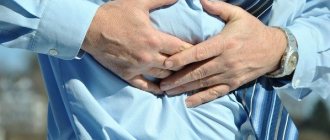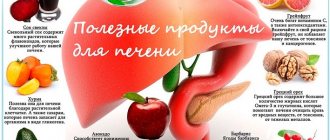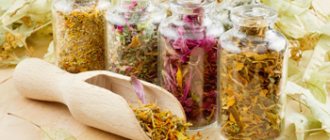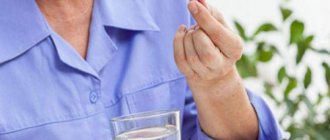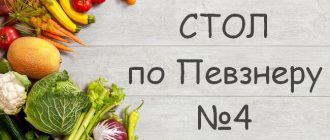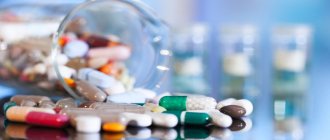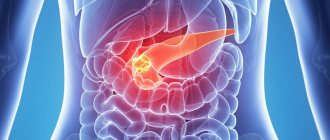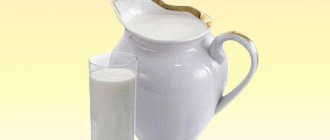General rules
Diet for gallbladder disease is an essential component of treatment for both acute and chronic forms of cholecystitis , cholangitis (inflammation of the bile ducts), and biliary dyskinesia . The basic diet for these diseases is Table No. 5 and its varieties.
In case of acute cholecystitis, in order to maximize sparing of the gastrointestinal tract in the first days, complete fasting is indicated. Only warm drinks in small portions are allowed: weak sweet tea, berry and fruit juices diluted with water, rosehip infusions. On days 3-4, an anti-inflammatory version of diet No. 5 is prescribed - Diet 5B .
Light food in pureed form without broth and butter is introduced into the diet in limited quantities: slimy soups (oatmeal, rice, semolina), liquid pureed oatmeal and rice porridges with a small addition of low-fat milk, pureed compotes, jellies, vegetable juices. Then include in small quantities well-mashed steamed meat, low-fat cottage cheese, boiled fish, wheat bread or crackers.
Meals are fractional, in small portions (at least 5 times), without sodium chloride , with plenty of liquid (up to 2.5 l/day). The calorie content of the daily diet is 1600 kcal (50-60 g protein, 40-45 g fat, 200-250 g carbohydrates). On days 8-10 the patient is transferred to Diet 5A and then to Diet No. 5 .
In case of chronic cholecystitis (without exacerbation), the main principles of dietary nutrition are maximum sparing of the gallbladder and liver with physiologically adequate nutrition, normalization of bile secretion and cholesterol in the blood, and in the absence of diarrhea , strengthening of intestinal function ( Diet No. 5 ).
Small and frequent meals are provided to promote the outflow of bile. To enhance bile secretion, salads and vinaigrettes seasoned with unrefined vegetable oils are introduced into the diet. The diet includes various vegetables, berries and fruits that stimulate the process of bile secretion, and the high fiber content eliminates constipation .
All easily digestible carbohydrates (jam, sugar, sweets, honey) are excluded or sharply limited from the diet, since their consumption leads to stagnation of bile, as well as vegetables containing oxalic acid (sorrel, spinach) and essential oils in large quantities (citrus fruits). The diet includes chicken eggs (not more than one), but it must be remembered that yolks enhance the motor function of the gallbladder and have a choleretic effect.
For pain or bitterness in the mouth caused by eating eggs, only egg whites are included in the diet. The calorie content of the daily diet is at the level of 2700-2900 kcal (proteins -100 g, including animals - 60%, fats -90 g, including vegetable 30%, carbohydrates -450 g).
Salt consumption is limited (10 g), liquid at the level of 1.5-2 liters. With a sharp exacerbation of chronic cholecystitis, the diet is similar to the diet for acute cholecystitis .
For combined diseases of the pancreas and gall bladder ( pancreatitis + cholecystitis ), Table No. 5P . This table is characterized by an increase in the content of proteins and vitamins and a restriction in the diet of fatty and carbohydrate foods.
Products containing a lot of extractives and purine bases (cabbage broth, meat and fish broths), refractory fats of animal origin, and sugar are excluded from the diet. Avoid hot, spicy, sour, sweet and fatty foods that stimulate the function of the pancreas, as well as foods rich in fiber. Food is cooked mainly by steaming, meals are divided into small portions. The total caloric content of the diet is reduced to 2500 Kcal.
Diet number 5
Diet as part of the treatment of gallbladder diseases
Diet plays an important role for people suffering from liver and gallbladder diseases. Compliance with it guarantees normal well-being. Often, with some deviations from it, an exacerbation immediately develops, and the person has to go on a strict diet. Today, people suffering from these diseases are recommended to adhere to diet number five, which was developed specifically taking into account the physiological characteristics of the liver and gall bladder. She has several options, each of which is different from the previous one.
Diet 5a is prescribed in the acute period of Botkin's disease, in the case of chronic liver diseases (for example, hepatitis), during exacerbation of cholecystitis, as well as in inflammatory processes in other organs, such as the stomach and intestines. The peculiarity of this diet is that the patient limits the consumption of fats, especially refractory fats, and cholesterol. In addition, special attention is paid to nitrogenous substances, essential oils and purines. Their content should be reduced as much as possible. As for carbohydrates and proteins, they remain unchanged.
Varieties
The varieties of Diet No. 5 include, in addition to those described above, also a lipotropic-fat diet - 5 l/f. Prescribed to patients with cholecystitis for problems caused by stagnation of bile. cholesterol from it .
The diet increased the fat content (50% of which is vegetable oils), slightly increased the protein content (up to 100 g) and reduced the amount of carbohydrates (300 g) by limiting sugar. Total calorie content is 2600 kcal.
The diet provides for a sharp limitation in the consumption of extractive substances (meat and fish broths), cholesterol and foods containing large amounts of essential oils. The diet is enriched with lipotropic protein products (egg whites, cottage cheese, lean meat, fish), refined vegetable oils, wheat bran, vegetables and fruits.
All types of oils (butter and vegetable) are added only to ready-made dishes. Refractory animal fats, butter dough, spices, and whole milk are excluded. Food is prepared by baking or boiling; chopping is not necessary.
Diet for biliary dyskinesia in children
It should be noted that this pathology is more common in older children, in whom parasympathetic influences predominate, which causes the development of a hypertensive type of dysfunction. During treatment, first of all, it is necessary to optimize the child’s lifestyle: normalize the duration of night sleep (8 hours in adolescents and 9–10 hours in younger schoolchildren). With asthenic syndrome, daytime sleep is also necessary. Limit your time watching TV (or working on the computer) to 3 hours a day. Physical activity and walking are an important therapeutic component for children with ADHD. The second important point is therapeutic nutrition, which is no different from that of adults, and medicinal nutrition (if prescribed by a doctor).
The diet for ADHD in children (of any type) excludes the use of:
- fatty, fried and spicy foods;
- fatty meat and fish;
- smoked meats, pickles, canned food, nuts, legumes, mushrooms, black bread, all broths, fresh baked goods;
- cocoa, carbonated drinks, chocolate, ice cream, chewing gum.
Allowed:
- vegetable-cereal and vegetable soups;
- lean meat, fish, poultry (boiled);
- cereals (rice, oatmeal, buckwheat);
- boiled vegetables;
- fermented milk products, cottage cheese and cottage cheese casseroles;
- omelet and soft-boiled eggs;
- dried white bread.
It is necessary to organize regular meals (5 times a day), observing meal times. For hypokinetic dyskinesia, additionally consume vegetable oil, sour cream, eggs, fresh vegetables (especially zucchini, carrots, beets), fruits and berries (strawberries, plums, strawberries, apples, apricots).
Authorized Products
Permitted products and dishes include vegetable and cereal soups with vegetable broth, beetroot soup, vegetarian cabbage soup, milk soups with pasta, fruit soups, dried wheat bread, dry biscuits, savory pastries with fish, boiled meat or cottage cheese, and apples. Meat - chicken fillet, lean young lamb, beef, rabbit, milk sausages. Low-fat white fish and seafood.
The diet should contain dairy products: kefir, fermented baked milk, yogurt, whole low-fat milk, low-fat cottage cheese and dishes based on it (casseroles, puddings, lazy dumplings), mild, low-fat cheese. Chicken eggs in the form of an omelet and soft-boiled eggs are allowed. Cereals (especially oatmeal and buckwheat), boiled pasta.
The diet should contain vegetables both raw and in various forms of cooking (stewed and boiled), non-acidic sauerkraut, green pea puree, vegetable salads with vegetable oil, vinaigrette, squash caviar, and greens. As snacks, the diet includes low-fat herring, diet, doctor's sausage, stuffed fish, lean ham, boiled fish and meat.
Sweet products include various non-acidic fruits and berries, dried fruits, marmalade, jam, honey, marshmallows. It is recommended to combine sugar with xylitol ( Sorbitol ). All fats (butter and vegetable oil) are introduced into the dish in their natural form. Recommended drinks: black/green tea, vegetable, fruit and berry juices, decoction of wheat bran and rose hips, still mineral water.
Table of permitted products
| Proteins, g | Fats, g | Carbohydrates, g | Calories, kcal | |
Vegetables and greens | ||||
| eggplant | 1,2 | 0,1 | 4,5 | 24 |
| squash caviar | 1,2 | 7,0 | 7,4 | 97 |
| cabbage | 1,8 | 0,1 | 4,7 | 27 |
| broccoli | 3,0 | 0,4 | 5,2 | 28 |
| bulb onions | 1,4 | 0,0 | 10,4 | 41 |
| carrot | 1,3 | 0,1 | 6,9 | 32 |
| cucumbers | 0,8 | 0,1 | 2,8 | 15 |
| salad pepper | 1,3 | 0,0 | 5,3 | 27 |
| parsley | 3,7 | 0,4 | 7,6 | 47 |
| radish | 1,2 | 0,1 | 3,4 | 19 |
| iceberg lettuce | 0,9 | 0,1 | 1,8 | 14 |
| tomatoes | 0,6 | 0,2 | 4,2 | 20 |
| dill | 2,5 | 0,5 | 6,3 | 38 |
Fruits | ||||
| bananas | 1,5 | 0,2 | 21,8 | 95 |
| apples | 0,4 | 0,4 | 9,8 | 47 |
Nuts and dried fruits | ||||
| nuts | 15,0 | 40,0 | 20,0 | 500 |
| raisin | 2,9 | 0,6 | 66,0 | 264 |
| dried apricots | 5,2 | 0,3 | 51,0 | 215 |
| almond | 18,6 | 57,7 | 16,2 | 645 |
| hazelnut | 16,1 | 66,9 | 9,9 | 704 |
| prunes | 2,3 | 0,7 | 57,5 | 231 |
Cereals and porridges | ||||
| buckwheat | 4,5 | 2,3 | 25,0 | 132 |
| oatmeal | 3,2 | 4,1 | 14,2 | 102 |
| pearl barley porridge | 3,1 | 0,4 | 22,2 | 109 |
| rice | 6,7 | 0,7 | 78,9 | 344 |
Flour and pasta | ||||
| pasta | 10,4 | 1,1 | 69,7 | 337 |
| pancakes | 6,1 | 12,3 | 26,0 | 233 |
Bakery products | ||||
| bran bread | 7,5 | 1,3 | 45,2 | 227 |
| whole grain bread | 10,1 | 2,3 | 57,1 | 295 |
Dairy | ||||
| kefir 1.5% | 3,3 | 1,5 | 3,6 | 41 |
| Ryazhenka | 2,8 | 4,0 | 4,2 | 67 |
Cheeses and cottage cheese | ||||
| cottage cheese 1% | 16,3 | 1,0 | 1,3 | 79 |
Meat products | ||||
| beef | 18,9 | 19,4 | 0,0 | 187 |
| rabbit | 21,0 | 8,0 | 0,0 | 156 |
Sausages | ||||
| boiled diet sausage | 12,1 | 13,5 | 0,0 | 170 |
| boiled milk sausage | 11,7 | 22,8 | 0,0 | 252 |
| milk sausages | 12,3 | 25,3 | 0,0 | 277 |
Bird | ||||
| boiled chicken breast | 29,8 | 1,8 | 0,5 | 137 |
| boiled chicken drumstick | 27,0 | 5,6 | 0,0 | 158 |
| boiled turkey fillet | 25,0 | 1,0 | — | 130 |
Eggs | ||||
| hard-boiled chicken eggs | 12,9 | 11,6 | 0,8 | 160 |
Fish and seafood | ||||
| flounder | 16,5 | 1,8 | 0,0 | 83 |
| pollock | 15,9 | 0,9 | 0,0 | 72 |
| cod | 17,7 | 0,7 | — | 78 |
| hake | 16,6 | 2,2 | 0,0 | 86 |
Oils and fats | ||||
| butter | 0,5 | 82,5 | 0,8 | 748 |
| olive oil | 0,0 | 99,8 | 0,0 | 898 |
| sunflower oil | 0,0 | 99,9 | 0,0 | 899 |
Non-alcoholic drinks | ||||
| water | 0,0 | 0,0 | 0,0 | — |
| green tea | 0,0 | 0,0 | 0,0 | — |
| * data is per 100 g of product | ||||
Table No. 5 (Diet for diseases of the liver and gall bladder)
Indications:
1) acute hepatitis and cholecystitis in the recovery stage;
2) chronic hepatitis without exacerbation;
3) cirrhosis of the liver without liver failure;
4) chronic cholecystitis and cholelithiasis without exacerbation. In all cases - without significant diseases of the stomach and intestines.
The purpose of diet No. 5: chemical sparing of the liver in conditions of adequate nutrition, to promote the normalization of liver functions and the activity of the biliary tract, and to improve bile secretion.
General characteristics of diet No. 5: physiologically normal content of proteins and carbohydrates with a slight restriction of fats (mainly refractory). And they exclude products rich in nitrogenous extractives, purines, cholesterol, oxalic acid, essential oils and fat oxidation products that arise during frying. The content of lipotropic substances, fiber, pectins, and liquids is increased. Dishes are prepared boiled, baked, and occasionally stewed. Only stringy meat and fiber-rich vegetables are pureed: flour and vegetables are not sautéed. Very cold dishes are excluded.
Chemical composition and calorie content of dietary table No. 5: carbohydrates - 400-450 g (70-80 g sugar), proteins - 90-100 g (60% animal), fats - 80-90 g (30% vegetable), 11, 7 -12.2 MJ (2800-2900 kcal), sodium chloride - 10 g, free liquid - 1.5-2 l. You can include xylitol and sorbitol (25-40 g).
Diet No. 5: 5 times a day.
Recommended and excluded foods and dishes:
- soups. Vegetables, cereals with vegetable broth, dairy with pasta, fruit, vegetarian borscht and cabbage soup, beetroot soup. Flour and vegetables for dressing are not fried, but dried. And they include: meat, fish and mushroom broths, okroshka, green cabbage soup;
- bread and flour products. Wheat bread from 1st and 2nd grade flour, rye bread from sifted and peeled flour baked yesterday. Baked savory products with boiled meat and fish, cottage cheese, apples. Long-lasting cookies, dry sponge cake. And they include: very fresh bread, puff pastry and pastry, fried pies;
- meat and poultry. Lean or fat-free, without fascia and tendons, poultry without skin. Beef, young lean lamb, pork, rabbit, chicken, turkey. Boiled, baked after boiling, in pieces and chopped. Stuffed cabbage rolls, pilaf with boiled meat. Milk sausages. And they include: fatty varieties, duck, goose, liver, kidneys, brains, smoked meats, most sausages, canned food;
- fish. Low-fat types. Boiled, baked after boiling, in pieces and in the form of quenelles, meatballs, souffle. And they include: fatty species, smoked, salted fish, canned food;
- dairy products. Milk, kefir, acidophilus, yogurt; sour cream - as a seasoning for dishes; semi-fat and low-fat cottage cheese and dishes made from it (casseroles, lazy dumplings, puddings, etc.). Belin dishes. Mild, low-fat cheese. Limit: cream, milk 6% fat, fermented baked milk, sour cream, fatty cottage cheese, salty, fatty cheese;
- eggs. Baked egg white omelette. Up to 1 yolk per day in dishes. If tolerated, use a soft-boiled egg, in the form of an omelet. And they include: hard-boiled and fried eggs. For cholelithiasis - up to ½ yolk per day in dishes;
- cereals. Any dishes made from different cereals, especially buckwheat and oatmeal. Pilaf with dried fruits, carrots, puddings with carrots and cottage cheese, krupeniki. Boiled pasta. And they include: legumes;
- vegetables. Various, raw, boiled, stewed - salads, side dishes, independent dishes. Non-acidic sauerkraut, onions after boiling, green pea puree. And they include: spinach, sorrel, radish, radish, green onions, garlic, mushrooms, pickled vegetables;
- snacks. Fresh vegetable salad with vegetable oil, fruit salads, vinaigrettes, squash caviar, jellied fish (after boiling), soaked, low-fat herring, stuffed fish, seafood salads, boiled fish and meat, doctor's sausage, milk sausage, dietary sausage, low-fat ham. mild, low-fat cheese. And they include: spicy and fatty snacks, canned food, smoked meats, caviar;
- fruits, sweet dishes, sweets. Various fruits and berries (except sour ones) - raw, boiled, baked. Dried fruits. Compotes, jelly, jellies, mousses, sambuca. Meringues, snowballs. Marmalade, non-chocolate candies, marshmallows, honey, jam. Partially replace sugar with xylitol (sorbitol). And they include: chocolate, cream products, ice cream;
- sauces and spices. Sour cream, milk, vegetable, sweet fruit sauces. The flour is not sautéed. Dill, parsley; vanillin, cinnamon. And they include: mustard, pepper, horseradish;
- beverages. Tea, coffee with milk, fruit, berry and vegetable juices, rosehip and wheat bran decoctions. And they include: black coffee, cocoa, cold drinks;
- fats. Butter in its natural form and in dishes, refined vegetable oils. And they include: pork, beef, lamb lard, cooking fats.
Sample diet menu No. 5.
First breakfast: cottage cheese with sugar and sour cream, oatmeal porridge, tea.
Second breakfast: baked apple.
Lunch: vegetarian vegetable soup with vegetable oil, boiled chicken in milk sauce, boiled rice, dried fruit compote.
Afternoon snack: rosehip decoction.
Dinner: boiled fish with white sauce and vegetable broth, mashed potatoes, cheesecake with cottage cheese, tea.
At night - kefir.
Table No. 5A
Indications:
acute hepatitis and cholecystitis in the initial stage, angiocholitis and other lesions of the biliary tract, diseases of the liver and biliary tract in combination with inflammatory gastric and intestinal diseases, or with ulcers of the stomach or duodenum.
The purpose of diet No. 5A: restoration of the functions of the liver and biliary tract, stimulation of bile secretion while simultaneously sparing the intestines and stomach, accumulation of glycogen in the liver.
General characteristics of diet No. 5A: a diet with complete energy value, with sufficient carbohydrates and proteins, with limited consumption of fats and foods rich in nitrogenous extractives, cholesterol, oxalic acid, and coarse fiber.
Chemical composition and calorie content of dietary table No. 5a: Proteins - 80-100 g (60% animal) Fats - 70-80 g (20-25% vegetable) Carbohydrates - 350-400 g (80-90 g sugar) Calories - 2350-2750 kcal Sodium chloride (table salt) - 8 g. Free liquid - 2-2.5 l.
Diet No. 5a: Food is taken 5 times a day, warm.
Recommended and excluded foods and dishes:
- bread and flour products. Dried or yesterday-baked wheat bread, uneaten cookies. And they include: fresh and rye bread, puff pastry and pastry products;
- meat and poultry. Lean and lean beef, turkey, skinless chicken, rabbit - all in the form of a cutlet mass. Allowed to steam or boil. And they include: fatty varieties, duck, game, goose meat, brains, liver, kidneys, smoked meats, sausages, canned food, fried and stewed meat in pieces;
- fish. Boiled, low-fat steamed fish, products in the form of cutlet mass (mashed potatoes, soufflé) from a boiled product, jellied fish in a decoction of vegetables. And they include: fatty types of fish, smoked, stewed, fried, salted, caviar and canned food;
- eggs. Protein steam omelette, 0.5 - 1 yolk per day in other dishes. And they include: all other types of preparation;
- dairy products. Milk (if tolerated), fermented milk drinks, low-fat and non-sour cottage cheese (dishes made from it, but pureed and steamed), sour cream (small amount in main dishes), mild and grated cheese. And they include: fatty and sour cottage cheese, sharp cheese, cream and natural milk for enterocolitis;
- fats. Creamy and refined vegetable products are scarce (limited quantities). And they include: all other fats;
- cereals, pasta and legumes. Milk porridge (1: 1 with water, semolina, mashed rolled oats, buckwheat, boiled rice. Semolina, rice and buckwheat soufflé, boiled vermicelli. And include: pearl barley, millet, barley groats, crumbly porridges, legumes and pasta;
- vegetables. Steamed, or raw and pureed, puree and soufflé. Zucchini and pumpkin should be boiled or stewed in pieces. And they include: radishes, turnips, radishes, cabbage, spinach, sorrel, onions, garlic, mushrooms, as well as salted, pickled and pickled vegetables;
- soups. Milk soups (1:1 with water), vegetarian soups with cereals (vegetables must be pureed), puree soups. You can top it with sour cream or butter. And they include: fish, meat, mushroom broths, as well as soups with undiluted cereals and vegetables;
- fruits, berries and sweets. Sweet and ripe berries and fruits (processed - raw and unprocessed, baked and boiled), jelly, marshmallows, jelly, mousse, marshmallow, honey, jam, sugar. And they include: hard and sour fruits, berries with hard grains, halva, chocolate, sweets with cream and ice cream.
- sauces and spices. On a decoction of vegetables or mucus from cereals, fruits and berries and dairy. And they are excluded: any spices.
- beverages. Tea with milk and lemon, coffee substitute with milk, rosehip infusion, tomato juice, sweet berry and fruit juices. And they exclude: natural coffee, cocoa, carbonated drinks and cold drinks.
Sample diet menu No. 5A:
First breakfast - steamed cottage cheese soufflé, pureed rice porridge with milk and water + tea
Second breakfast - 1 apple, baked with sugar
Lunch - vegetarian pearl barley soup with pureed vegetables, steamed meat cutlets with carrot puree + jelly
Afternoon snack - rosehip decoction
Dinner - steamed fish dumplings, mashed potatoes, semolina casserole with sweet gravy + tea
Before bed - kefir.
Table No. 5P
Indications:
chronic pancreatitis during the recovery period after an exacerbation and outside of an exacerbation.
The purpose of diet No. 5P: to normalize (the function of the pancreas, to provide mechanical and chemical sparing of the stomach and intestines, to reduce the excitability of the gallbladder, to prevent fatty infiltration of the liver and pancreas.
General characteristics of diet No. 5P: a diet with a high protein content, reduced fat and carbohydrates, in particular sugar. Extractive substances, purines, refractory fats, cholesterol, essential oils, coarse fiber are sharply limited. Fried foods are excluded. The amount of vitamins and lipotropic substances has been increased. Dishes are mainly pureed and chopped, boiled in water or steamed, baked. Hot and very cold dishes are excluded.
Chemical composition and calorie content of dietary table No. 5P: proteins - 110-120 g (60-65% animal), fats - 80 g (15-20% vegetable), carbohydrates - 350-400 g (30-40 g sugar); calories - 2600-2700 kcal, 20-30 g of xylitol instead of sugar in sweet dishes, sodium chloride (table salt) - 10 g, free liquid - 1.5 l.
Diet No. 5P: 5-6 times a day.
Recommended and excluded foods and dishes:
- soups. Vegetarian pureed with potatoes, carrots, zucchini, pumpkin; with semolina, oatmeal, buckwheat, rice, noodles. Add 5 g butter or 10 g sour cream. And they include: meat, fish broth, decoction of mushrooms and vegetables, with millet, milk soups, borscht, cabbage soup, cold - okroshka, beetroot soup;
- bread and flour products. Wheat bread made from 1st and 2nd grade flour, dried or yesterday's bread, in the form of crackers. Unsweetened dry cookies. And they include: rye and fresh bread, puff pastry and pastry products;
- meat and poultry. Lean varieties of beef, veal, rabbit, chicken, turkey. The meat is freed from fascia, tendons, and fat; poultry - from the skin. Boiled or steamed. pureed and chopped (cutlets, dumplings, puree, soufflé, beef stroganoff, etc.). Lean chicken, rabbit, veal - in pieces, boiled. And they include: fatty varieties, duck, goose, fried, stewed, smoked meats, sausages, canned food, liver, brains, kidneys;
- fish. Low-fat boiled, in pieces and chopped. Jellied after boiling. And they include: fatty species, fried and stewed, smoked, salted fish, canned fish, caviar;
- dairy products. Mostly low fat. Fresh non-acidic cottage cheese 9% fat and low-fat, calcined in natural form, infusion, steam and baked puddings Milk - if tolerated. Fermented milk drinks. Sour cream and cream - in dishes. The cheese is low-fat and mild. And they include: dairy products with high fat content and the inclusion of sugar;
- eggs. White omelettes from 2 eggs, yolks - limited (up to ½ per day) in dishes. And they include: dishes made from whole eggs, especially hard-boiled, fried;
- cereals. Mashed and semi-viscous porridges made from oatmeal, buckwheat, semolina, rice, boiled in water and half and half with milk. Cereal souffles, puddings with cottage cheese, casseroles. Boiled pasta. And they include: legumes, crumbly porridges, limit pearl barley, barley, corn grits, millet;
- vegetables. Boiled and baked in pureed form. Potatoes, carrots, cauliflower, speckle, zucchini, pumpkin, green peas. And includes: white cabbage, eggplant, radish, turnip, radish, onion, garlic, sorrel, spinach, sweet pepper, mushrooms;
- snacks. And they include;
- fruits, sweet dishes and sweets. Ripe soft, non-acidic fruits and berries, pureed raw; baked apples; pureed compotes from fresh and dried fruits, jellies, mousses with xylitol (sorbitol) or semi-sweet with sugar. And they include: raw unprocessed fruits and berries, grapes, dates, figs, bananas, confectionery, chocolate, jam, ice cream;
- sauces and spices. Dairy; semi-sweet fruit and berry sauces; in a weak vegetable broth. The flour is not sautéed. And they include: meat, fish, mushroom broth, tomato, all spices;
- beverages. Weak tea with lemon, semi-sweet or with xylitol, milk. Rose hip decoction. Fruit and berry juices without sugar, diluted with water, as tolerated. And they include: coffee, cocoa, carbonated and cold drinks, grape juice;
- fats. Butter (30 g), refined vegetable oils (10-15 g) - in dishes. And they include: other fats.
Sample diet menu No. 5P.
First breakfast: boiled meat, oatmeal porridge, tea.
Second breakfast: steamed protein omelet, rosehip decoction.
Lunch: vegetarian soup of chopped vegetables, boiled beef stroganoff, boiled potatoes, compote of pureed dried fruits.
Afternoon snack: sour cream cottage cheese, tea with milk.
Dinner: boiled fish, carrot puree, tea with milk.
At night: kefir.
PS Before switching to a therapeutic diet, be sure to consult your doctor!
VKontakte
Email
Fully or partially limited products
Mushroom, meat and fish broths, green cabbage soup, and okroshka are completely excluded from the menu; solid animal fats (cooking fats, pork, lamb lard), fatty pork, goose meat, duck meat, offal (brains, liver, kidneys), most sausages, smoked meats, canned food, fresh bread, dough (butter, puff pastry), fried pies, fried and hard-boiled chicken eggs, smoked, salted and fatty fish, canned fish, full-fat cottage cheese, cream, whole milk 6% fat, sour cream, salted cheese, seasonings (pepper, mustard, horseradish) and sauces.
Irritating gastrointestinal tract and difficult-to-digest products of plant origin are limited: all types of legumes (peas, beans, chickpeas, soybeans), mushrooms, sorrel, radishes, spinach, radishes, green onions, garlic, pickled and canned vegetables. You cannot include spicy and fatty snacks, various caviar, as well as ice cream, chocolate, confectionery, cocoa, carbonated and alcohol-containing drinks, black coffee, sour berries, fruits, and juices from these products in your diet.
Table of prohibited products
| Proteins, g | Fats, g | Carbohydrates, g | Calories, kcal | |
Vegetables and greens | ||||
| canned vegetables | 1,5 | 0,2 | 5,5 | 30 |
| peas | 6,0 | 0,0 | 9,0 | 60 |
| chickpeas | 19,0 | 6,0 | 61,0 | 364 |
| beans | 7,8 | 0,5 | 21,5 | 123 |
| spinach | 2,9 | 0,3 | 2,0 | 22 |
| sorrel | 1,5 | 0,3 | 2,9 | 19 |
Berries | ||||
| grape | 0,6 | 0,2 | 16,8 | 65 |
Snacks | ||||
| potato chips | 5,5 | 30,0 | 53,0 | 520 |
Flour and pasta | ||||
| vareniki | 7,6 | 2,3 | 18,7 | 155 |
Bakery products | ||||
| sliced loaf | 7,5 | 2,9 | 50,9 | 264 |
| buns | 7,9 | 9,4 | 55,5 | 339 |
Confectionery | ||||
| cookie | 7,5 | 11,8 | 74,9 | 417 |
Ice cream | ||||
| ice cream | 3,7 | 6,9 | 22,1 | 189 |
Chocolate | ||||
| chocolate | 5,4 | 35,3 | 56,5 | 544 |
Raw materials and seasonings | ||||
| mayonnaise | 2,4 | 67,0 | 3,9 | 627 |
Dairy | ||||
| milk 4.5% | 3,1 | 4,5 | 4,7 | 72 |
| cream 35% (fat) | 2,5 | 35,0 | 3,0 | 337 |
Cheeses and cottage cheese | ||||
| gouda cheese | 25,0 | 27,0 | 2,0 | 356 |
| parmesan cheese | 33,0 | 28,0 | 0,0 | 392 |
Meat products | ||||
| fatty pork | 11,4 | 49,3 | 0,0 | 489 |
| salo | 2,4 | 89,0 | 0,0 | 797 |
| bacon | 23,0 | 45,0 | 0,0 | 500 |
Sausages | ||||
| smoked sausage | 9,9 | 63,2 | 0,3 | 608 |
Bird | ||||
| duck | 16,5 | 61,2 | 0,0 | 346 |
| goose | 16,1 | 33,3 | 0,0 | 364 |
Fish and seafood | ||||
| salmon | 19,8 | 6,3 | 0,0 | 142 |
| salmon | 21,6 | 6,0 | — | 140 |
| trout | 19,2 | 2,1 | — | 97 |
Alcoholic drinks | ||||
| white dessert wine 16% | 0,5 | 0,0 | 16,0 | 153 |
| dry red wine | 0,2 | 0,0 | 0,3 | 68 |
| vodka | 0,0 | 0,0 | 0,1 | 235 |
| beer | 0,3 | 0,0 | 4,6 | 42 |
Non-alcoholic drinks | ||||
| soda water | 0,0 | 0,0 | 0,0 | — |
| cola | 0,0 | 0,0 | 10,4 | 42 |
| * data is per 100 g of product | ||||
Menu (Power Mode)
It is necessary to organize 6 meals a day and ensure that the diet includes alternating protein dishes (beef, chicken, fish, turkey, cottage cheese) and cereals.
Below is a three-day nutrition menu of the main Table No. 5 , which can be modified at will, observing the basic principles of processing and not going beyond the limits of permitted products.
First day
| Breakfast |
|
| Lunch |
|
| Dinner |
|
| Afternoon snack |
|
| Dinner |
|
| For the night |
|
Second day
| Breakfast |
|
| Lunch |
|
| Dinner |
|
| Afternoon snack |
|
| Dinner |
|
| For the night |
|
The third day
| Breakfast |
|
| Lunch |
|
| Dinner |
|
| Afternoon snack |
|
| Dinner |
|
| For the night |
|
Menu for a week for a diet after removal of the gallbladder for adults with recipes
The daily menu after gallbladder removal depends primarily on how long ago the operation was performed.
The strictest diet awaits patients immediately after the surgery. In the first hours after the operation, eating is prohibited. The day after cholecystectomy, you are allowed to drink rosehip decoction without sugar and still water. You need to drink in small sips and no more than 1-1.5 liters per day. Then liquid porridges and pureed soups made with water or vegetable broth are introduced into the diet.
The first week after surgery is the strictest; specific recommendations can only be prescribed by the attending physician. Further, the diet becomes more varied.
Expert's choice
The best drugs for the treatment of cholecystitis according to KP
Diet recipes
First meal
Zucchini soup
Ingredients: zucchini, potatoes, tomatoes, carrots, onions, parsley (root), butter, vegetable broth, sour cream 10%.
Vegetables: carrots, onions, parsley root, chop and simmer in water with added butter. Place the chopped potatoes into the vegetable broth, and after 15 minutes add the stewed roots, chopped zucchini, tomato, and salt. When serving, sprinkle with chopped herbs. Serve with sour cream if desired.
Vegetarian pearl barley soup
Ingredients: potatoes, cereals, carrots, onions, parsley (root), butter, sour cream 10%.
Boil pearl barley until half cooked. Chop the carrots, parsley root, onion and simmer in water with butter. Combine the cereal with the roots, pour in the vegetable broth, add potatoes, and salt. Serve with parsley and sour cream.
Second courses
Stuffed cabbage rolls with boiled meat and rice
Composition of products. Cabbage, tomatoes, rice, parsley, meat, sour cream, salt.
Disassemble the head of cabbage and cook the leaves until half cooked in salted water. Pass the meat through a meat grinder, combine with cooked rice and herbs. Spread the minced meat on the leaves and wrap. Place the cabbage rolls in a saucepan, add vegetable broth and put on fire. After boiling, add salt. Place chopped tomato and grated carrots on top and cook covered. Serve with sour cream.
Casserole of boiled chicken and vegetables
Ingredients: chicken, flour, butter, milk, carrots, cauliflower, tomato, zucchini, egg white, vegetable oil, salt.
Finely chop the boiled chicken meat, add part of the milk sauce (made from flour and milk) and whipped egg white. Place the minced meat in a mold, place chopped vegetables on top and stew them in butter and water. Pour in the remaining milk sauce, butter and bake in the oven.
Pasta with boiled meat
Ingredients: beef, onion, pasta, vegetable oil, egg, milk, salt. Boil the meat, finely chop, add onion. Boil the pasta. Place a layer of pasta in a deep dish, spread out the minced meat and the second layer of pasta. Prepare a sauce from beaten eggs, milk and salt, pour it over the pasta bowl and bake.
Pike perch baked in sour cream
Ingredients: pike perch fillet, sour cream sauce, onion, salt.
Place pike perch fillet or carcass pieces in a mold, add salt, sprinkle with onion rings, pour in sour cream sauce and bake.
Hake poached with vegetables
Ingredients: hake, onion, zucchini, carrots, bell pepper, tomato, vegetable oil.
Place the hake fillet in a saucepan. Simmer diced zucchini, tomato and sweet pepper, and grated carrots in a frying pan with the addition of vegetable oil and water. Transfer the prepared vegetables to the fish, add salt and simmer under the lid until cooked.
Dessert
Cheesecakes with carrots and dried apricots
Ingredients: cottage cheese; 0.5 eggs; flour; sugar; carrot; dried apricots; butter; sour cream 10%.
Grate the carrots and simmer with a little water and butter. Chop the dried apricots. Mash the cottage cheese well, add flour, egg, a little sour cream, dried apricots, carrots and sugar. Mix everything, form cheesecakes, bake in the oven. Serve with sour cream.
Pumpkin porridge with millet
Ingredients: peeled pumpkin, butter, milk, millet cereal, sugar.
Chop the pumpkin and simmer with milk and water until soft. Add cooked cereal, sugar and salt. Cook until done, adding milk or water if necessary. Can be served with butter.
Dry biscuit
Ingredients: two eggs, 50 g flour, 40 g sugar.
Prepared from biscuit dough, baked in the form of flat cakes or sticks. Beat eggs with sugar until the mass increases 3 times. Add the sifted flour and mix gently. Place the dough in the form of sticks on a baking sheet with baking paper, greased with oil. Sprinkle the products with sugar and bake for 10-15 minutes at 2400.
Advantages and disadvantages
| pros | Minuses |
|
|
Reviews and results
Feedback from patients confirms the need for therapeutic nutrition, which has a beneficial effect on the gastrointestinal tract. As a result of such nutrition, the patients’ condition improves significantly: heaviness in the right hypochondrium, bloating of the intestines decrease, belching and constipation . More often there are reviews from patients with chronic cholecystitis , hepatitis and those who have had viral hepatitis A.
- “... I have chronic cholecystitis. During an exacerbation, she was treated in a hospital and prescribed a diet for the gallbladder. I've been sticking to it for two months now. For me, this is the only way out, otherwise it will worsen again”;
- “... After Botkina’s illness, she ate this way for 4 months. I’m used to it, the food is nutritious, almost all foods are acceptable, except fatty and fried foods”;
- “... In case of exacerbation of cholecystitis, as soon as the first symptoms of gallbladder disease appear, I immediately go on a diet. As it subsides, I’m gradually expanding my diet”;
- “... I prepared this for my child for six months when he suffered from viral hepatitis”;
- “... The food is healthy and wholesome, I don’t feel inferior, although I eat like this all the time. What is the use of fried belyashi and chebureks?”;
- “... I cook everything for my husband in a double boiler (he has chronic calculous cholecystitis) and have taught the whole family to eat this way. This is healthy eating";
- “... After cholecystectomy, I sat on table 5 for 2 months, then I started eating everything, little by little”;
- “... Due to illness, I started eating this way, and my family got used to stewed and low-fat dishes”;
- “... Nutritional therapy makes sense. During an exacerbation, I strictly monitor my diet for a month and noticed that I even lose weight during this time.”
Popular questions and answers
We discussed how to eat properly after removal of the gallbladder with an endocrinologist and nutritionist Ekaterina Kazachkova .
Is the diet after gallbladder removal for life?
— A strict diet must be maintained for the first 3-4 months after surgical treatment. Depending on the pace of recovery (and they are very individual), over time the daily menu can gradually expand. However, you need to remember that you need to introduce new products gradually, in small quantities and be sure to monitor the body’s reaction, and only after consultation with your doctor.
What can a lack of diet lead to in the first month after surgery?
— If you do not follow the recommended diet, the risk of postoperative complications increases, such as postoperative diarrhea, dysfunction of the sphincter of Oddi, which leads to pain and digestive disorders.
Is it possible to form stones after gallbladder removal?
- Yes, this happens, but it is extremely rare when stones can form in the bile ducts.
To prevent this situation, it is recommended to adhere to a diet on an ongoing basis. Sources :
- Laparoscopic cholecystectomy. Koshenov M.R. Bulletin of Surgery of Kazakhstan, 2012. https://cyberleninka.ru/article/n/laparoskopicheskaya-holetsistektomiya-1/viewer
- Dysfunction of the sphincter of Oddi in the postcholecystectomy period. Bueverov A.O. Medical Council, 2022. https://cyberleninka.ru/article/n/disfunktsiya-sfinktera-oddi-v-postholetsistektomicheskom-periode/viewer
- Modern view on the problem of postcholecystectomy syndrome. Neresov A.V., Kaibulaeva D.A., Vasnev O.S., Tashenova L.K., Sakhipov M.M., Berestimov G.T. and others. Pharmacoeconomics. Modern pharmacoeconomics and pharmacoepidemiology. https://cyberleninka.ru/article/n/sovremennyy-vzglyad-na-problemu-postholetsistektomicheskogo-sindroma-po-materialam-ekspertnogo-soveta-sostoyavshegosya-4-maya-2019/viewer
